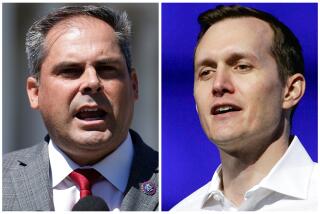Howard Berman in the 30th Congressional District
In June, San Fernando Valley voters winnowed a field of seven candidates for the 30th Congressional District seat to the two clear leaders: Democratic Reps. Howard Berman and Brad Sherman, who are now facing off as a result of redistricting that forced them to go head to head. They were the standouts of that field, so it was natural that they both made the runoff. But now the time has come for the really difficult choice. One will stay in Congress; the other will leave it. The Times supported Berman in the first round of voting, and we’re sticking with him in the head to head.
FOR THE RECORD:
28th District: A Sept. 23 editorial endorsing Rep. Howard Berman for reelection said his district has been concentrated on Los Angeles’ Westside. In fact, the 28th Congressional District has been concentrated in the east San Fernando Valley. —
That is no slight to Sherman. He’s a solid member of Congress with a strong voting record and evident devotion to the interests and well-being of his constituents. Under most circumstances, he would be a shoo-in for reelection and would deserve enthusiastic support.
In this case, however, he’s up against one of the most senior and respected members of the House. Berman is an admired leader in foreign affairs, a clear thinker and the rare congressman these days who has friends and admirers in both political parties. That ability to work with others has helped build Berman’s record of achievement in areas such as environmental protection, where he helped create the Santa Monica Mountains Conservancy, and intellectual property, where he has fought for the interests of his Hollywood constituents. Indeed, one of the more notable aspects of Berman’s campaign in recent weeks has been his ability to secure endorsements from significant Republicans, specifically Arizona Sen. John McCain and South Carolina Sen. Lindsey Graham — adding their support to that of California’s two Democratic senators, its Democratic governor and most of its House delegation. The depth and breadth of his backing is testament to Berman’s influence in Washington and to his willingness to work across party lines at a time when bipartisanship is increasingly undervalued on Capitol Hill.
ENDORSEMENTS: The Times’ recommendations for Nov. 6
There are a handful of issues on which Berman and Sherman differ. To cite two, Berman is a more enthusiastic supporter of free trade — backing trade pacts that are good for the U.S. economy and those of its trading partners — and he has played a more responsible role in addressing the economic collapse in 2008, when he supported the Bush administration’s rescue plan. Moreover, while both support immigration reform, Berman has been a leading advocate for immigrants and farm workers for decades. Those positions reflect his pragmatism, compassion and level-headedness, more reasons to want him to remain in Congress.
Nevertheless, Sherman is believed to have a significant geographical advantage over Berman. Although Berman has historically represented some constituents in the San Fernando Valley, his district has been concentrated in Los Angeles’ Westside. Sherman, on the other hand, has always represented the Valley, which is where the new district is mostly based. That’s one reason Sherman finished first in the June primary by 10 percentage points, and why he has been favored in recent polls to win in November as well.
The so-called Berman-Sherman campaign is not a dream come true for liberal Democrats. It ensures that money and energy is being spent by Democrats to beat Democrats in a year when most would like to see those efforts exerted elsewhere. Nevertheless, one of these admirable public servants will soon wind it up while the other returns to Washington. Forced to choose, we choose Berman.
More to Read
A cure for the common opinion
Get thought-provoking perspectives with our weekly newsletter.
You may occasionally receive promotional content from the Los Angeles Times.










